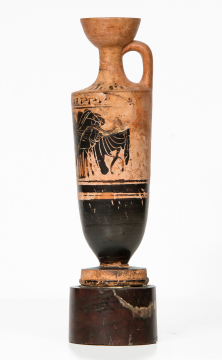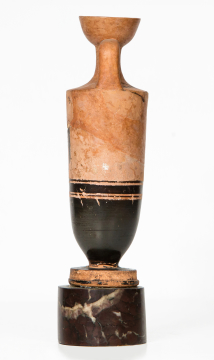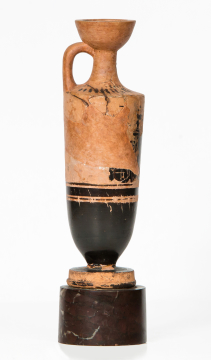Explore Collections


You are here:
CollectionsOnline
/
An Attic (Greek) lekythos
Browse
An Attic (Greek) lekythos
Pre 475 BC
Before the second quarter of the 5th century BC
Before the second quarter of the 5th century BC
Attica
The area known as 'Attica' is the region of south-eastern Greece ruled by Athens in ancient times.
The area known as 'Attica' is the region of south-eastern Greece ruled by Athens in ancient times.
Black glaze in red clay
Height: 18.5cm
Diameter: 6cm
Diameter: 6cm
Museum number: HR10
On display: Picture Room Recess (pre-booked tours only)
All spaces are in No. 13 Lincoln's Inn Fields unless identified as in No. 12, Soane's first house.
For tours https://www.soane.org/your-visit
Curatorial note
A lekythos is a Greek pottery vessel used for storing oil, especially olive oil. It has a narrow body and one handle attached to the neck of the vessel and was often used in rituals. The lekythos was used for annointing the bodies of unmarried men during funeral rituals and these vessels are therefore often found in tombs. Their decoration is often in outline in sombre colours, and their subjects often scenes of daily life or rituals but also frequently a scene of loss or funeral rites or with a sense of depature.
In this case the figurative scene of the much damaged decoration features a quadriga [chariot drawn by four horses] with Dionysos and Ariadne(?) and two attendant figures. Compare Corpus Vasorum Antiquorum, Karlsruhe, plate 14, 7-8 and the parallels quoted in the text.
In this case the figurative scene of the much damaged decoration features a quadriga [chariot drawn by four horses] with Dionysos and Ariadne(?) and two attendant figures. Compare Corpus Vasorum Antiquorum, Karlsruhe, plate 14, 7-8 and the parallels quoted in the text.
Literature
Description of Sir John Soane's Museum, 1930, p.95, fig. 57.
Associated items
HR24, object displayed on this
Soane collections online is being continually updated. If you wish to find out more or if you have any further information about this object please contact us: worksofart@soane.org.uk









